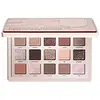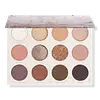What's inside
What's inside
 Key Ingredients
Key Ingredients

 Benefits
Benefits

 Concerns
Concerns

 Ingredients Side-by-side
Ingredients Side-by-side

Calcium Aluminum Borosilicate
Mica
Cosmetic ColorantC30-45 Alkyl Dimethicone
Skin ConditioningStearyl Dimethicone
EmollientLauryl Dimethicone
Skin ConditioningCI 77891
Cosmetic ColorantCellulose Acetate
CI 77491
Cosmetic ColorantSorbitan Isostearate
EmulsifyingCI 77499
Cosmetic ColorantPolysorbate 60
EmulsifyingTriacetin
AntimicrobialCaprylyl Glycol
EmollientEthylhexylglycerin
Skin ConditioningTin Oxide
AbrasiveCI 77492
Cosmetic ColorantWater
Skin ConditioningSilica
AbrasiveZinc Stearate
Cosmetic ColorantCI 77000
Cosmetic ColorantPentaerythrityl Tetra-Di-T-Butyl Hydroxyhydrocinnamate
AntioxidantTocopherol
AntioxidantDiisostearyl Malate
EmollientSynthetic Fluorphlogopite
Dimethicone
EmollientDicalcium Phosphate
AbrasiveDimethicone/Vinyl Dimethicone Crosspolymer
Skin ConditioningHydrogenated Styrene/Isoprene Copolymer
Lauroyl Lysine
Skin ConditioningLaureth-4
EmulsifyingCI 75470
Cosmetic ColorantTriethoxycaprylylsilane
Hdi/Trimethylol Hexyllactone Crosspolymer
Maltodextrin
AbsorbentCI 77007
Cosmetic ColorantTalc
AbrasiveKaolin
AbrasiveCalcium Sodium Borosilicate
CI 19140
Cosmetic ColorantAlumina
AbrasiveOctyldodecyl Stearoyl Stearate
EmollientCI 77163
Cosmetic ColorantCI 77510
Cosmetic ColorantAluminum Calcium Sodium Silicate
Calcium Aluminum Borosilicate, Mica, C30-45 Alkyl Dimethicone, Stearyl Dimethicone, Lauryl Dimethicone, CI 77891, Cellulose Acetate, CI 77491, Sorbitan Isostearate, CI 77499, Polysorbate 60, Triacetin, Caprylyl Glycol, Ethylhexylglycerin, Tin Oxide, CI 77492, Water, Silica, Zinc Stearate, CI 77000, Pentaerythrityl Tetra-Di-T-Butyl Hydroxyhydrocinnamate, Tocopherol, Diisostearyl Malate, Synthetic Fluorphlogopite, Dimethicone, Dicalcium Phosphate, Dimethicone/Vinyl Dimethicone Crosspolymer, Hydrogenated Styrene/Isoprene Copolymer, Lauroyl Lysine, Laureth-4, CI 75470, Triethoxycaprylylsilane, Hdi/Trimethylol Hexyllactone Crosspolymer, Maltodextrin, CI 77007, Talc, Kaolin, Calcium Sodium Borosilicate, CI 19140, Alumina, Octyldodecyl Stearoyl Stearate, CI 77163, CI 77510, Aluminum Calcium Sodium Silicate
Synthetic Fluorphlogopite
Talc
AbrasiveBoron Nitride
AbsorbentZinc Stearate
Cosmetic ColorantLauroyl Lysine
Skin ConditioningMagnesium Stearate
Cosmetic ColorantDimethicone
EmollientCaprylic/Capric Triglyceride
MaskingSilica
AbrasivePhenoxyethanol
PreservativeCaprylyl Glycol
EmollientDimethiconol
EmollientEthylhexylglycerin
Skin ConditioningHexylene Glycol
EmulsifyingCI 42090
Cosmetic ColorantIron Oxides
CI 77742
Cosmetic ColorantMica
Cosmetic ColorantCI 16035
Cosmetic ColorantCI 77891
Cosmetic ColorantCI 77007
Cosmetic ColorantCI 19140
Cosmetic ColorantAluminum Starch Octenylsuccinate
AbsorbentQuartz
AbrasiveCI 75470
Cosmetic ColorantCalcium Sodium Borosilicate
CI 77163
Cosmetic ColorantPolyethylene Terephthalate
Magnesium Myristate
Polyurethane-33
Tin Oxide
AbrasiveCI 77000
Cosmetic ColorantCI 77491
Cosmetic ColorantAlumina
AbrasiveAluminum Calcium Sodium Silicate
Ricinus Communis Seed Oil
MaskingDiisostearyl Malate
EmollientPolyglyceryl-10 Pentaisostearate
EmollientPolymethyl Methacrylate
Chlorphenesin
AntimicrobialDehydroacetic Acid
PreservativeAluminum PCA
AstringentSynthetic Fluorphlogopite, Talc, Boron Nitride, Zinc Stearate, Lauroyl Lysine, Magnesium Stearate, Dimethicone, Caprylic/Capric Triglyceride, Silica, Phenoxyethanol, Caprylyl Glycol, Dimethiconol, Ethylhexylglycerin, Hexylene Glycol, CI 42090, Iron Oxides, CI 77742, Mica, CI 16035, CI 77891, CI 77007, CI 19140, Aluminum Starch Octenylsuccinate, Quartz, CI 75470, Calcium Sodium Borosilicate, CI 77163, Polyethylene Terephthalate, Magnesium Myristate, Polyurethane-33, Tin Oxide, CI 77000, CI 77491, Alumina, Aluminum Calcium Sodium Silicate, Ricinus Communis Seed Oil, Diisostearyl Malate, Polyglyceryl-10 Pentaisostearate, Polymethyl Methacrylate, Chlorphenesin, Dehydroacetic Acid, Aluminum PCA
Ingredients Explained
These ingredients are found in both products.
Ingredients higher up in an ingredient list are typically present in a larger amount.
Alumina is another name for the compound aluminum oxide. It is used as a thickener, absorbent, and abrasive.
As an absorbent, alumina can give a mattifying effect. It is used in mineral sunscreens to help coat nano-sized filters, such as titanium dioxide. By increasing the size of the UV filters, these ingredients stay on the skin for a longer time. By coating small sized ingredients, alumina helps thicken a product.
Alumina may be used as an abrasive, or exfoliant.
Alumina is naturally occurring in the mineral corundum. Certain varieties of corundum create rubies and sapphires. Corundum is also the crystalline form of alumina.
Learn more about AluminaThis ingredient is a silicate that contains aluminum, calcium, and sodium. It is used to add bulk to formulations and for its anti-caking properties.
Silicates are large particles that remain on the skin's surface.
There are no known cancer or neurotoxicity concerns at typical use levels.
Learn more about Aluminum Calcium Sodium SilicateCalcium Sodium Borosilicate is a bulking agent. It is considered a borosilicate glass; it is composed of powder or flakes of calcium and sodium borosilicates.
This ingredient is used to add volume, shine, and color to products. You'll most likely find this ingredient in makeup products.
According to in-vivo and ex-vivo studies done by a manufacturer, this ingredient works well with UV filters:
Learn more about Calcium Sodium BorosilicateCaprylyl Glycol is a humectant and emollient, meaning it attracts and preserves moisture.
It is a common ingredient in many products, especially those designed to hydrate skin. The primary benefits are retaining moisture, skin softening, and promoting a healthy skin barrier.
Though Caprylyl Glycol is an alcohol derived from fatty acids, it is not the kind that can dry out skin.
This ingredient is also used as a preservative to extend the life of products. It has slight antimicrobial properties.
Learn more about Caprylyl GlycolCI 19140 is also known as Tartrazine. Tartrazine is a synthetic dye used in cosmetics, foods, and medicine to add a yellow color.
Tartrazine is created from petroleum and is water-soluble.
Some people may experience allergies from this dye, especially asthmatics and those with an aspirin intolerance.
Learn more about CI 19140Ci 75470 is a bright-red pigment. It is AKA carmine.
Carmine is derived from insects such as the cochineal beetle. This ingredient has been used as a natural dye for over 2000 years.
We don't have a description for CI 77000 yet.
This pigment is called Ultramarine blue lazurite. It gives a saturated blue color, but can be used to create other colors as well.
According to the manufacturer, it is usually made from kaolin, sodium sulfate, sodium carbonate, sulfur, and charcoal.
This synthetic powder is used to add a pearly/white color in cosmetics.
Ci 77491 is also hydrated iron III oxide. It's sole purpose is to give a red/pink hue to products.
Iron III oxides are classified as inorganic chemicals for coloring.
Synthetically created Ci 77491 is considered safer than those naturally found. This is because the synthetically created version may contain less impurities. Iron oxides are generally non-toxic and non-allergenic.
Learn more about CI 77491Ci 77891 is a white pigment from Titanium dioxide. It is naturally found in minerals such as rutile and ilmenite.
It's main function is to add a white color to cosmetics. It can also be mixed with other colors to create different shades.
Ci 77891 is commonly found in sunscreens due to its ability to block UV rays.
Learn more about CI 77891Diisostearyl Malate is an emollient and most often used in lip products. It comes from isostearyl alcohol, a fatty acid, and malic acid, an AHA.
As an emollient, Diisostearyl Malate helps create a thin film on your skin to trap moisture in. This helps keep your skin soft and smooth.
Dimethicone is a type of synthetic silicone created from natural materials such as quartz.
What it does:
Dimethicone comes in different viscosities:
Depending on the viscosity, dimethicone has different properties.
Ingredients lists don't always show which type is used, so we recommend reaching out to the brand if you have questions about the viscosity.
This ingredient is unlikely to cause irritation because it does not get absorbed into skin. However, people with silicone allergies should be careful about using this ingredient.
Note: Dimethicone may contribute to pilling. This is because it is not oil or water soluble, so pilling may occur when layered with products. When mixed with heavy oils in a formula, the outcome is also quite greasy.
Learn more about DimethiconeEthylhexylglycerin (we can't pronounce this either) is commonly used as a preservative and skin softener. It is derived from glyceryl.
You might see Ethylhexylglycerin often paired with other preservatives such as phenoxyethanol. Ethylhexylglycerin has been found to increase the effectiveness of these other preservatives.
This ingredient comes from a fatty acid (lauric acid) and amino acid (lysine). It is used to add a silky feel to cosmetics.
According to a manufacturer, its fatty acid base leaves a silky feeling on the skin. It also has emollient properties because of this. Emollients help soften skin by preventing water from evaporating.
Lauroyl lysine is barely soluble in water.
Learn more about Lauroyl LysineMica is a naturally occurring mineral used to add shimmer and color in cosmetics. It can also help improve the texture of a product or give it an opaque, white/silver color.
Serecite is the name for very fine but ragged grains of mica.
This ingredient is often coated with metal oxides like titanium dioxide. Trace amounts of heavy metals may be found in mica, but these metals are not harmful in our personal products.
Mica has been used since prehistoric times throughout the world. Ancient Egyptian, Indian, Greek, Roman, Aztec, and Chinese civilizations have used mica.
Learn more about MicaSilica, also known as silicon dioxide, is a naturally occurring mineral. It is used as a fine, spherical, and porous powder in cosmetics.
Though it has exfoliant properties, the function of silica varies depending on the product.
The unique structure of silica enhances the spreadability and adds smoothness, making it a great texture enhancer.
It is also used as an active carrier, emulsifier, and mattifier due to its ability to absorb excess oil.
In some products, tiny microneedles called spicules are made from silica or hydrolyzed sponge. When you rub them in, they lightly polish away dead skin layers and enhance the penetration of active ingredients.
Learn more about SilicaSynthetic Fluorphlogopite is the synthethic version of mica. It consists of fluorine, aluminum and silicate.
Synthetic Fluorphlogopite is used to add volume to products.
It is considered non-irritating on the skin.
Learn more about Synthetic FluorphlogopiteTalc is a clay mineral. It helps absorb moisture and improve the texture of products. Like other types of clay, Talc can have a slight exfoliating effect on skin. Talc can be added to increase the volume of products.
Some Baby powders are made by combining talc with corn starch. The word "talc" comes from Latin and originates from Arabic. Talc is a mineral commonly found throughout the world.
If you have any concerns about using talc, we recommend checking out the FDA's official page.
Learn more about TalcTin Oxide is an inorganic oxide used to add opacity and volume to a product. In nature, it is already found in mineral form. The main ore of tin is an opaque and shiny mineral called casseterite.
Tin Oxide helps remove translucency in a product, or make it more opaque. Besides adding opacity, tin oxide is used for bulking to add volume.
Zinc Stearate is the metal salt of stearic acid. It is a white solid used to bind, thicken, and lubricate products.
This ingredient is common in powder makeup, where it helps keep the powder together.
Zinc Stearate is hydrophobic and repels water.
This ingredient can be sourced from non-animal or animal sources. It is best to reach out to the brand to see where they source this ingredient from.
Learn more about Zinc Stearate